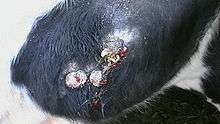Actinomycosis in animals



Actinomycosis in animals is caused by Actinomyces bovis (whereas human infections are usually due to A. israelii).
Actinomycosis is a quite common condition in cattle, where it is referred to as lumpy jaw or senfed (moroccan arabic), but it can also occur in horses, swine, dogs and rarely in sheep. In all these species, actinomycosis results in cold abscess, with granulomatous formations on the fistulised place.
Actinomycosis in cattle
It is a common condition in weaned calves, young bulls, and heifers. The disease has a chronic course, and the general condition can remain quite good.
There is a swelling of the maxilla and mandible. Fistulisation occurs after some days, leaving a thick, yellowish, non-odorous pus, with mineralised, 2 to 5 mm grains therein.
Later on, a granuloma will form in the place of fistulisation.
The bony lesions are followed by periostitis, with permanent deformation of the facial bones.
Causes
The Actinomyces bacteria that cause lumpy jaw are always present in a healthy cattle's mouth. In order for infection to occur, there must be tissue damage, which is often caused by unusually rough feed that scratches the mouth of the animal or by contact with sharp objects, such as sticks or brambles.[1] Given the mode of infection, lumpy jaw is not contagious.
Treatment
The affected areas are treated with iodine solutions. A common method to achieve this is to give the cattle sodium iodide orally on a regular treatment schedule. Antibiotics such as Tetracyclines are also used. These two treatment methods can be used alone or together; simultaneous use is considered more aggressive. Killing the bacteria that cause the infection is the ultimately purpose of these treatment methods. However, they are seldom effective unless treatment is started very early.[1][2]
It is notable that surgery is not typically considered for treatment of cattle as it is in extreme human cases.[3]
Misdiagnosis
As is often the case, there are diseases/conditions with signs and symptoms that are similar to actinomycosis. As such, misdiagnoses can occur. Some examples include abscesses caused by grass seeds, woody tongue, bottle jaw, cancerous growths, and irritation caused by lodges objects.[1]
References
- 1 2 3 Roche, M., & Warrnambool. (2015). Lumpy jaw. Retrieved from http://agriculture.vic.gov.au/agriculture/pests-diseases-and-weeds/animal-diseases/beef-and-dairy-cows/lumpy-jaw
- ↑ Smith, G. W. (2013). Overview of Actinomycosis. In The Merck Veterinary Manual (Actinomycosis). Retrieved from http://www.merckvetmanual.com/mvm/generalized_conditions/actinomycosis/overview_of_actinomycosis.html
- ↑ Okulicz, J. F. (2016). Actinomycosis Treatment & Management. Retrieved from http://emedicine.medscape.com/article/211587-treatment
External links
| Wikimedia Commons has media related to Actinomyces bovis. |